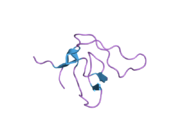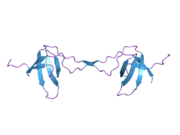Biology:CRKL
From HandWiki
 Generic protein structure example |
Crk-like protein is a protein that in humans is encoded by the CRKL gene.[1][2]
Function
v-CRK avian sarcoma virus CT10-homolog-like contains one SH2 domain and two SH3 domains. CRKL has been shown to activate the RAS and JUN kinase signaling pathways and transform fibroblasts in a RAS-dependent fashion. It is a substrate of the BCR-ABL tyrosine kinase and plays a role in fibroblast transformation by BCR-ABL. In addition, CRKL has oncogenic potential.[3]
CrkL together with Crk participates in the Reelin signaling cascade downstream of DAB1.[4][5]
Interactions
CRKL has been shown to interact with:
- Abl gene,[6][7][8]
- BCAR1,[9][10]
- BCR gene,[7][11][12][13]
- CBLB,[14]
- CD117,[15][16]
- CD34,[17]
- Cbl gene,[6][16][18][19][20][21][22][23][24][25]
- Dock2,[26]
- EPOR,[18][27]
- GAB1,[28]
- GAB2,[29]
- INPP5D,[27]
- MAP4K1,[30][31][32]
- MAP4K5,[33]
- NEDD9,[6][10][24][34]
- PIK3R2,[16]
- Paxillin[35][36]
- RAPGEF1,[6][18][28][37][38][39][40]
- RICS,[41]
- STAT5A,[42]
- Syk,[43] and
- WAS.[43]
See also
- Crk
References
- ↑ "Isolation and chromosomal localization of CRKL, a human crk-like gene". Oncogene 8 (9): 2469–74. September 1993. PMID 8361759.
- ↑ "The CRKL adaptor protein transforms fibroblasts and functions in transformation by the BCR-ABL oncogene". The Journal of Biological Chemistry 271 (38): 23255–61. September 1996. doi:10.1074/jbc.271.38.23255. PMID 8798523.
- ↑ "Entrez Gene: CRKL v-crk sarcoma virus CT10 oncogene homolog (avian)-like". https://www.ncbi.nlm.nih.gov/sites/entrez?Db=gene&Cmd=ShowDetailView&TermToSearch=1399.
- ↑ "Reduction of Crk and CrkL expression blocks reelin-induced dendritogenesis". Journal of Cell Science 121 (11): 1869–75. June 2008. doi:10.1242/jcs.027334. PMID 18477607.
- ↑ "Crk and Crk-like play essential overlapping roles downstream of disabled-1 in the Reelin pathway". The Journal of Neuroscience 28 (50): 13551–62. December 2008. doi:10.1523/JNEUROSCI.4323-08.2008. PMID 19074029.
- ↑ 6.0 6.1 6.2 6.3 "Differential interaction of Crkl with Cbl or C3G, Hef-1, and gamma subunit immunoreceptor tyrosine-based activation motif in signaling of myeloid high affinity Fc receptor for IgG (Fc gamma RI)". Journal of Immunology 161 (10): 5555–63. November 1998. PMID 9820532.
- ↑ 7.0 7.1 "Direct binding of CRKL to BCR-ABL is not required for BCR-ABL transformation". Blood 89 (1): 297–306. January 1997. doi:10.1182/blood.V89.1.297. PMID 8978305.
- ↑ "Abl protein-tyrosine kinase selects the Crk adapter as a substrate using SH3-binding sites". Genes & Development 8 (7): 783–95. April 1994. doi:10.1101/gad.8.7.783. PMID 7926767.
- ↑ "p130CAS forms a signaling complex with the adapter protein CRKL in hematopoietic cells transformed by the BCR/ABL oncogene". The Journal of Biological Chemistry 271 (41): 25198–203. October 1996. doi:10.1074/jbc.271.41.25198. PMID 8810278.
- ↑ 10.0 10.1 "Association of the Cas-like molecule HEF1 with CrkL following integrin and antigen receptor signaling in human B-cells: potential relevance to neoplastic lymphohematopoietic cells". Leukemia & Lymphoma 28 (1–2): 65–72. December 1997. doi:10.3109/10428199709058332. PMID 9498705.
- ↑ "The SH2-containing adapter protein GRB10 interacts with BCR-ABL". Oncogene 17 (8): 941–8. August 1998. doi:10.1038/sj.onc.1202024. PMID 9747873.
- ↑ "CRKL binding to BCR-ABL and BCR-ABL transformation". Leukemia & Lymphoma 33 (1–2): 119–26. March 1999. doi:10.3109/10428199909093732. PMID 10194128.
- ↑ "A direct binding site for Grb2 contributes to transformation and leukemogenesis by the Tel-Abl (ETV6-Abl) tyrosine kinase". Molecular and Cellular Biology 24 (11): 4685–95. June 2004. doi:10.1128/MCB.24.11.4685-4695.2004. PMID 15143164.
- ↑ "Tyrosine phosphorylation and complex formation of Cbl-b upon T cell receptor stimulation". Oncogene 18 (5): 1147–56. February 1999. doi:10.1038/sj.onc.1202411. PMID 10022120.
- ↑ "Stem cell factor induces phosphatidylinositol 3'-kinase-dependent Lyn/Tec/Dok-1 complex formation in hematopoietic cells". Blood 96 (10): 3406–13. November 2000. doi:10.1182/blood.V96.10.3406. PMID 11071635. https://pure.eur.nl/en/publications/395fb5fc-60e3-45d7-a9b1-fc7b9cc6b4bc.
- ↑ 16.0 16.1 16.2 "Steel factor induces tyrosine phosphorylation of CRKL and binding of CRKL to a complex containing c-kit, phosphatidylinositol 3-kinase, and p120(CBL)". The Journal of Biological Chemistry 272 (15): 10248–53. April 1997. doi:10.1074/jbc.272.15.10248. PMID 9092574.
- ↑ "The adapter protein CrkL associates with CD34". Blood 97 (12): 3768–75. June 2001. doi:10.1182/blood.v97.12.3768. PMID 11389015.
- ↑ 18.0 18.1 18.2 "Erythropoietin and IL-3 induce tyrosine phosphorylation of CrkL and its association with Shc, SHP-2, and Cbl in hematopoietic cells". Biochemical and Biophysical Research Communications 239 (2): 412–7. October 1997. doi:10.1006/bbrc.1997.7480. PMID 9344843.
- ↑ "All-trans-retinoic acid induces tyrosine phosphorylation of the CrkL adapter in acute promyelocytic leukemia cells". Experimental Hematology 28 (7): 826–32. July 2000. doi:10.1016/s0301-472x(00)00170-3. PMID 10907644.
- ↑ "The involvement of the proto-oncogene p120 c-Cbl and ZAP-70 in CD2-mediated T cell activation". International Immunology 13 (1): 13–22. January 2001. doi:10.1093/intimm/13.1.13. PMID 11133830.
- ↑ "CBL-GRB2 interaction in myeloid immunoreceptor tyrosine activation motif signaling". Journal of Immunology 160 (10): 5018–27. May 1998. PMID 9590251.
- ↑ "c-Cbl is involved in Met signaling in B cells and mediates hepatocyte growth factor-induced receptor ubiquitination". Journal of Immunology 169 (7): 3793–800. October 2002. doi:10.4049/jimmunol.169.7.3793. PMID 12244174.
- ↑ "Cbl functions downstream of Src kinases in Fc gamma RI signaling in primary human macrophages". Journal of Leukocyte Biology 65 (4): 523–34. April 1999. doi:10.1002/jlb.65.4.523. PMID 10204582.
- ↑ 24.0 24.1 "Differential signaling after beta1 integrin ligation is mediated through binding of CRKL to p120(CBL) and p110(HEF1)". The Journal of Biological Chemistry 272 (22): 14320–6. May 1997. doi:10.1074/jbc.272.22.14320. PMID 9162067.
- ↑ "Interleukin-2 stimulation induces tyrosine phosphorylation of p120-Cbl and CrkL and formation of multimolecular signaling complexes in T lymphocytes and natural killer cells". The Journal of Biological Chemistry 273 (7): 3986–93. February 1998. doi:10.1074/jbc.273.7.3986. PMID 9461587.
- ↑ "DOCK2 associates with CrkL and regulates Rac1 in human leukemia cell lines". Blood 100 (12): 3968–74. December 2002. doi:10.1182/blood-2001-11-0032. PMID 12393632.
- ↑ 27.0 27.1 "CrkL is recruited through its SH2 domain to the erythropoietin receptor and plays a role in Lyn-mediated receptor signaling". The Journal of Biological Chemistry 276 (35): 33282–90. August 2001. doi:10.1074/jbc.M102924200. PMID 11443118.
- ↑ 28.0 28.1 "Signaling of hepatocyte growth factor/scatter factor (HGF) to the small GTPase Rap1 via the large docking protein Gab1 and the adapter protein CRKL". The Journal of Biological Chemistry 275 (15): 10772–8. April 2000. doi:10.1074/jbc.275.15.10772. PMID 10753869.
- ↑ "A yeast two-hybrid study of human p97/Gab2 interactions with its SH2 domain-containing binding partners". FEBS Letters 495 (3): 148–53. April 2001. doi:10.1016/s0014-5793(01)02373-0. PMID 11334882.
- ↑ "The germinal center kinase (GCK)-related protein kinases HPK1 and KHS are candidates for highly selective signal transducers of Crk family adapter proteins". Oncogene 17 (15): 1893–901. October 1998. doi:10.1038/sj.onc.1202108. PMID 9788432.
- ↑ "Interaction of hematopoietic progenitor kinase 1 with adapter proteins Crk and CrkL leads to synergistic activation of c-Jun N-terminal kinase". Molecular and Cellular Biology 19 (2): 1359–68. February 1999. doi:10.1128/MCB.19.2.1359. PMID 9891069.
- ↑ "Involvement of hematopoietic progenitor kinase 1 in T cell receptor signaling". The Journal of Biological Chemistry 276 (22): 18908–14. June 2001. doi:10.1074/jbc.M101485200. PMID 11279207.
- ↑ "Adaptor proteins CRK and CRKL associate with the serine/threonine protein kinase GCKR promoting GCKR and SAPK activation". Blood 95 (3): 776–82. February 2000. doi:10.1182/blood.V95.3.776.003k23_776_782. PMID 10648385.
- ↑ "Involvement of p130(Cas) and p105(HEF1), a novel Cas-like docking protein, in a cytoskeleton-dependent signaling pathway initiated by ligation of integrin or antigen receptor on human B cells". The Journal of Biological Chemistry 272 (7): 4230–6. February 1997. doi:10.1074/jbc.272.7.4230. PMID 9020138.
- ↑ "CRKL links p210BCR/ABL with paxillin in chronic myelogenous leukemia cells". The Journal of Biological Chemistry 270 (49): 29145–50. December 1995. doi:10.1074/jbc.270.49.29145. PMID 7493940.
- ↑ "Hic-5-reduced cell spreading on fibronectin: competitive effects between paxillin and Hic-5 through interaction with focal adhesion kinase". Molecular and Cellular Biology 21 (16): 5332–45. August 2001. doi:10.1128/MCB.21.16.5332-5345.2001. PMID 11463817.
- ↑ "Engagement of the CrkL adaptor in interferon alpha signalling in BCR-ABL-expressing cells". British Journal of Haematology 112 (2): 327–36. February 2001. doi:10.1046/j.1365-2141.2001.02556.x. PMID 11167825.
- ↑ "The type I interferon receptor mediates tyrosine phosphorylation of the CrkL adaptor protein". The Journal of Biological Chemistry 272 (48): 29991–4. November 1997. doi:10.1074/jbc.272.48.29991. PMID 9374471.
- ↑ "Sos, Vav, and C3G participate in B cell receptor-induced signaling pathways and differentially associate with Shc-Grb2, Crk, and Crk-L adaptors". The Journal of Biological Chemistry 271 (15): 8564–9. April 1996. doi:10.1074/jbc.271.15.8564. PMID 8621483.
- ↑ "Nerve growth factor activates persistent Rap1 signaling in endosomes". The Journal of Neuroscience 21 (15): 5406–16. August 2001. doi:10.1523/JNEUROSCI.21-15-05406.2001. PMID 11466412.
- ↑ "Grit, a GTPase-activating protein for the Rho family, regulates neurite extension through association with the TrkA receptor and N-Shc and CrkL/Crk adapter molecules". Molecular and Cellular Biology 22 (24): 8721–34. December 2002. doi:10.1128/mcb.22.24.8721-8734.2002. PMID 12446789.
- ↑ "Association of CrkL with STAT5 in hematopoietic cells stimulated by granulocyte-macrophage colony-stimulating factor or erythropoietin". Biochemical and Biophysical Research Communications 252 (3): 779–86. November 1998. doi:10.1006/bbrc.1998.9445. PMID 9837784.
- ↑ 43.0 43.1 "CrkL is an adapter for Wiskott-Aldrich syndrome protein and Syk". Blood 97 (9): 2633–9. May 2001. doi:10.1182/blood.v97.9.2633. PMID 11313252.
Further reading
- "Physiological signals and oncogenesis mediated through Crk family adapter proteins". Journal of Cellular Physiology 177 (4): 535–52. December 1998. doi:10.1002/(SICI)1097-4652(199812)177:4<535::AID-JCP5>3.0.CO;2-E. PMID 10092207.
- "CRKL links p210BCR/ABL with paxillin in chronic myelogenous leukemia cells". The Journal of Biological Chemistry 270 (49): 29145–50. December 1995. doi:10.1074/jbc.270.49.29145. PMID 7493940.
- "Abl protein-tyrosine kinase selects the Crk adapter as a substrate using SH3-binding sites". Genes & Development 8 (7): 783–95. April 1994. doi:10.1101/gad.8.7.783. PMID 7926767.
- "Crkl is the major tyrosine-phosphorylated protein in neutrophils from patients with chronic myelogenous leukemia". The Journal of Biological Chemistry 269 (37): 22925–8. September 1994. doi:10.1016/S0021-9258(17)31596-X. PMID 8083188.
- "Sos, Vav, and C3G participate in B cell receptor-induced signaling pathways and differentially associate with Shc-Grb2, Crk, and Crk-L adaptors". The Journal of Biological Chemistry 271 (15): 8564–9. April 1996. doi:10.1074/jbc.271.15.8564. PMID 8621483.
- "p130CAS forms a signaling complex with the adapter protein CRKL in hematopoietic cells transformed by the BCR/ABL oncogene". The Journal of Biological Chemistry 271 (41): 25198–203. October 1996. doi:10.1074/jbc.271.41.25198. PMID 8810278.
- "B cell antigen receptor signaling induces the formation of complexes containing the Crk adapter proteins". The Journal of Biological Chemistry 271 (50): 32306–14. December 1996. doi:10.1074/jbc.271.50.32306. PMID 8943292.
- "Direct binding of CRKL to BCR-ABL is not required for BCR-ABL transformation". Blood 89 (1): 297–306. January 1997. doi:10.1182/blood.V89.1.297. PMID 8978305.
- "Involvement of p130(Cas) and p105(HEF1), a novel Cas-like docking protein, in a cytoskeleton-dependent signaling pathway initiated by ligation of integrin or antigen receptor on human B cells". The Journal of Biological Chemistry 272 (7): 4230–6. February 1997. doi:10.1074/jbc.272.7.4230. PMID 9020138.
- "Tyrosine 207 in CRKL is the BCR/ABL phosphorylation site". Oncogene 14 (5): 507–13. February 1997. doi:10.1038/sj.onc.1200885. PMID 9053848.
- "The BCR/ABL oncogene alters interaction of the adapter proteins CRKL and CRK with cellular proteins". Leukemia 11 (3): 376–85. March 1997. doi:10.1038/sj.leu.2400590. PMID 9067577.
- "Steel factor induces tyrosine phosphorylation of CRKL and binding of CRKL to a complex containing c-kit, phosphatidylinositol 3-kinase, and p120(CBL)". The Journal of Biological Chemistry 272 (15): 10248–53. April 1997. doi:10.1074/jbc.272.15.10248. PMID 9092574.
- "Differential signaling after beta1 integrin ligation is mediated through binding of CRKL to p120(CBL) and p110(HEF1)". The Journal of Biological Chemistry 272 (22): 14320–6. May 1997. doi:10.1074/jbc.272.22.14320. PMID 9162067.
- "CSF-1 stimulation induces the formation of a multiprotein complex including CSF-1 receptor, c-Cbl, PI 3-kinase, Crk-II and Grb2". Oncogene 14 (19): 2331–8. May 1997. doi:10.1038/sj.onc.1201074. PMID 9178909.
- "Erythropoietin and IL-3 induce tyrosine phosphorylation of CrkL and its association with Shc, SHP-2, and Cbl in hematopoietic cells". Biochemical and Biophysical Research Communications 239 (2): 412–7. October 1997. doi:10.1006/bbrc.1997.7480. PMID 9344843.
- "The type I interferon receptor mediates tyrosine phosphorylation of the CrkL adaptor protein". The Journal of Biological Chemistry 272 (48): 29991–4. November 1997. doi:10.1074/jbc.272.48.29991. PMID 9374471.
- "BCR/ABL-induced leukemogenesis causes phosphorylation of Hef1 and its association with Crkl". The Journal of Biological Chemistry 272 (51): 32649–55. December 1997. doi:10.1074/jbc.272.51.32649. PMID 9405482.
- "Interleukin-2 stimulation induces tyrosine phosphorylation of p120-Cbl and CrkL and formation of multimolecular signaling complexes in T lymphocytes and natural killer cells". The Journal of Biological Chemistry 273 (7): 3986–93. February 1998. doi:10.1074/jbc.273.7.3986. PMID 9461587.
External links
- Human CRKL genome location and CRKL gene details page in the UCSC Genome Browser.




